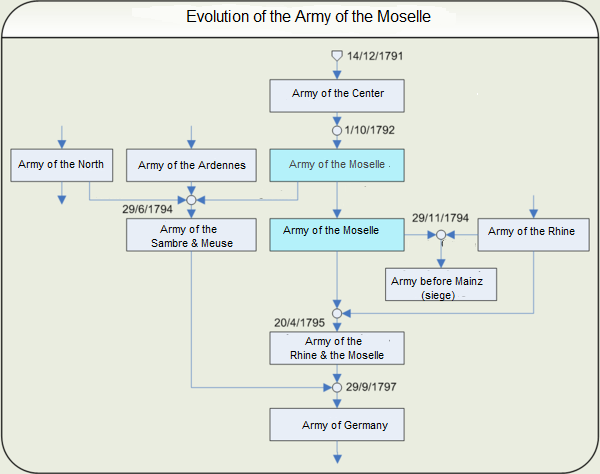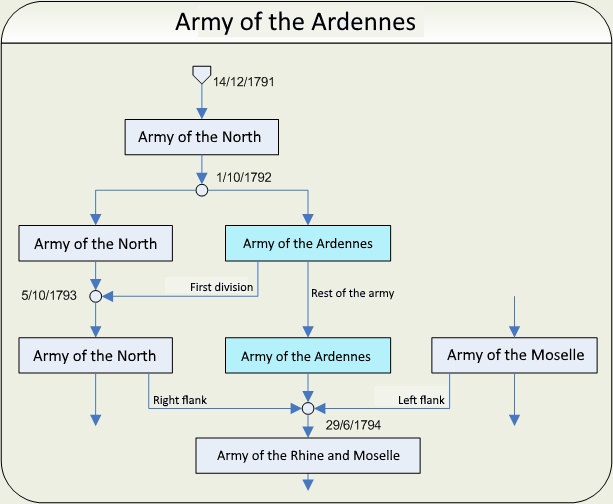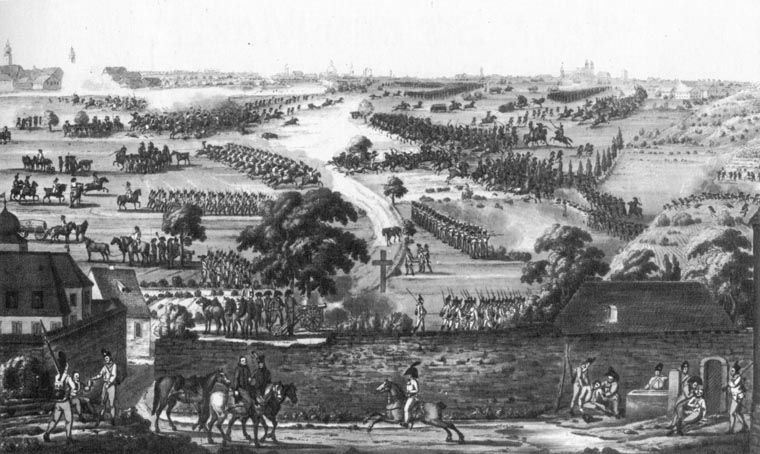|
Army Of Moselle
The Army of the Moselle (''Armée de la Moselle'') was a French Revolutionary Army from 1791 through 1795. It was first known as the ''Army of the Centre'' and it fought at Valmy. In October 1792 it was renamed and subsequently fought at Trier, First Arlon, Biesingen, Kaiserslautern, Froeschwiller and Second Wissembourg. In the spring of 1794 the left wing was detached and fought at Second Arlon, Lambusart and Fleurus before being absorbed by the ''Army of Sambre-et-Meuse''. In late 1794, the army captured Trier and initiated the Siege of Luxembourg. During the siege, the army was discontinued and its divisions were assigned to other armies. History Originally known as the ''Army of the Centre'', it was renamed by decree of the National Convention on 1 October 1792 and kept under that name in the decrees of 1 March and 30 April 1793. By the decree of 29 June 1794 its left wing joined with the ''Army of the Ardennes'' and the right wing of the ''Army of the North'' to form th ... [...More Info...] [...Related Items...] OR: [Wikipedia] [Google] [Baidu] |
French First Republic
In the history of France, the First Republic (french: Première République), sometimes referred to in historiography as Revolutionary France, and officially the French Republic (french: République française), was founded on 21 September 1792 during the French Revolution. The First Republic lasted until the declaration of the First Empire on 18 May 1804 under Napoléon Bonaparte, although the form of the government changed several times. This period was characterized by the fall of the monarchy, the establishment of the National Convention and the Reign of Terror, the Thermidorian Reaction and the founding of the Directory, and, finally, the creation Creation may refer to: Religion *''Creatio ex nihilo'', the concept that matter was created by God out of nothing * Creation myth, a religious story of the origin of the world and how people first came to inhabit it * Creationism, the belief tha ... of the French Consulate, Consulate and Napoleon's rise to power. End of the m ... [...More Info...] [...Related Items...] OR: [Wikipedia] [Google] [Baidu] |
Jean Nicolas Houchard
Jean Nicolas Houchard (24 January 1739 – 17 November 1793) was a French General of the French Revolution and the French Revolutionary Wars. Biography Born at Forbach in Lorraine, Houchard began his military career at the age of sixteen in the Régiment de Royal-Allemand cavalerie. He became a captain in the Bourbon-Dragons regiment in Corsica and took part in the Battle of Ponte Novu against rioters led by Pasquale Paoli, receiving a deep sabre cut across his cheek and a gunshot wound to his mouth which left him disfigured. Houchard was a fervent ''patriot'' (supporter of the French Revolution). Phipps describes Houchard as "Brave & stupid... Tall, brave, a proved 'patriot'". In 1792, he was colonel of a regiment of Chasseurs-à-cheval in the army of General Custine. On 11 April 1793 Houchard was appointed as Commander-in-Chief of the Army of the Moselle and when Custine was guillotined, Houchard replaced him in August as Commander-in-Chief of the Army of the North. Asses ... [...More Info...] [...Related Items...] OR: [Wikipedia] [Google] [Baidu] |
Army Of The Rhine And Moselle
The Army of the Rhine and Moselle (french: Armée de Rhin-et-Moselle) was one of the field units of the French Revolutionary Army. It was formed on 20 April 1795 by the merger of elements of the Army of the Rhine and the Army of the Moselle. The Army of the Rhine and Moselle participated in two principal campaigns in the War of the First Coalition. Military planners in Paris formed armies based on specific strategic tasks, and the task of this Army was to secure the French frontier at the Rhine and to penetrate the German states, potentially threatening Vienna. The unsuccessful 1795 campaign concluded with the removal of General Jean-Charles Pichegru from command. In 1796, under the command of General Jean Victor Marie Moreau, the Army was more successful. After crushing the ''Reichsarmee''s elements at Kehl, the Army advanced into southwestern Germany. Its success depended on the cooperation with France's Army of the Sambre and Meuse, commanded by Jean-Baptiste Jourdan. In 1796 ... [...More Info...] [...Related Items...] OR: [Wikipedia] [Google] [Baidu] |
Army Of The Rhine (France)
An army (from Old French ''armee'', itself derived from the Latin verb ''armāre'', meaning "to arm", and related to the Latin noun ''arma'', meaning "arms" or "weapons"), ground force or land force is a fighting force that fights primarily on land. In the broadest sense, it is the land-based military branch, service branch or armed service of a nation or country. It may also include aviation assets by possessing an army aviation component. Within a national military force, the word army may also mean a field army. In some countries, such as France and China, the term "army", especially in its plural form "armies", has the broader meaning of armed forces as a whole, while retaining the colloquial sense of land forces. To differentiate the colloquial army from the formal concept of military force, the term is qualified, for example in France the land force is called ''Armée de terre'', meaning Land Army, and the air and space force is called ''Armée de l'Air et de l’Espace' ... [...More Info...] [...Related Items...] OR: [Wikipedia] [Google] [Baidu] |
Army Of The North (France)
The Army of the North or Armée du Nord is a name given to several historical units of the French Army. The first was one of the French Revolutionary Armies that fought with distinction against the First Coalition from 1792 to 1795. Others existed during the Peninsular War, the Hundred Days and the Franco-Prussian War. Campaigns 1791 to 1797 At the creation of the Army of the North on 14 December 1791, the government of the Kingdom of France appointed Jean-Baptiste Donatien de Vimeur, Comte de Rochambeau, as its commander. Rochambeau was replaced in May 1792, and he retired from service. The suspicious government of the First French Republic later charged him with treason and he barely escaped execution. In 1792-1794, the guillotine awaited military commanders who either failed, belonged to the nobility, or displayed insufficient revolutionary zeal. In the Army of the North these unfortunates included Nicolas Luckner, Adam Custine, and Jean Houchard. Under Charles François ... [...More Info...] [...Related Items...] OR: [Wikipedia] [Google] [Baidu] |
Army Of The Ardennes
The Army of the Ardennes (''armée des Ardennes'') was a French Revolutionary Army formed on the first of October 1792 by splitting off the right wing of the Army of the North, commanded from July to August that year by La Fayette. From July to September 1792 General Dumouriez also misused the name Army of the Ardennes for the right wing of what was left of the Army of the North after the split, encamped at Sedan and the name of Army of the North for the left flank of the army. It was reorganized by a decree of the Conseil exécutif on the first of March 1793, leading to only the right flank of the army keeping the name of Army of the Ardennes. The first division of the Army of the Ardennes re-merged back into the Army of the North on 5 October 1793, at which date the rest of the Army of the Ardennes continued as the Army of the Ardennes until 29 June 1794, when it merged with the Army of the North's right wing and the Army of the Moselle's left wing to form the Army of Sambr ... [...More Info...] [...Related Items...] OR: [Wikipedia] [Google] [Baidu] |
National Convention
The National Convention (french: link=no, Convention nationale) was the parliament of the Kingdom of France for one day and the French First Republic for the rest of its existence during the French Revolution, following the two-year National Constituent Assembly and the one-year Legislative Assembly. Created after the great insurrection of 10 August 1792, it was the first French government organized as a republic, abandoning the monarchy altogether. The Convention sat as a single-chamber assembly from 20 September 1792 to 26 October 1795 (4 Brumaire IV under the Convention's adopted calendar). The Convention came about when the Legislative Assembly decreed the provisional suspension of King Louis XVI and the convocation of a National Convention to draw up a new constitution with no monarchy. The other major innovation was to decree that deputies to that Convention should be elected by all Frenchmen twenty-one years old or more, domiciled for a year and living by the produc ... [...More Info...] [...Related Items...] OR: [Wikipedia] [Google] [Baidu] |
Trier
Trier ( , ; lb, Tréier ), formerly known in English as Trèves ( ;) and Triers (see also names in other languages), is a city on the banks of the Moselle in Germany. It lies in a valley between low vine-covered hills of red sandstone in the west of the state of Rhineland-Palatinate, near the border with Luxembourg and within the important Moselle wine region. Founded by the Celts in the late 4th century BC as ''Treuorum'' and conquered 300 years later by the Romans, who renamed it ''Augusta Treverorum'' ("The City of Augustus among the Treveri"), Trier is considered Germany's oldest city. It is also the oldest seat of a bishop north of the Alps. Trier was one of the four capitals of the Roman Empire during the Tetrarchy period in the late 3rd and early 4th centuries. In the Middle Ages, the archbishop-elector of Trier was an important prince of the Church who controlled land from the French border to the Rhine. The archbishop-elector of Trier also had great signific ... [...More Info...] [...Related Items...] OR: [Wikipedia] [Google] [Baidu] |
Army Of Sambre-et-Meuse
The Army of Sambre and Meuse (french: Armée de Sambre-et-Meuse) was one of the armies of the French Revolution. It was formed on 29 June 1794 by combining the Army of the Ardennes, the left wing of the Army of the Moselle and the right wing of the Army of the North. Its maximum paper strength (in 1794) was approximately 120,000. After an inconclusive campaign in 1795, the French planned a co-ordinated offensive in 1796 using Jean-Baptiste Jourdan's Army of the Sambre et Meuse and the Army of the Rhine and Moselle commanded by his superior, Jean Victor Moreau. The first part of the operation called for Jourdan to cross the Rhine north of Mannheim and divert the Austrians while the Army of the Moselle crossed the southern Rhine at Kehl and Huningen. This was successful and, by July 1796, a series of victories forced the Austrians, commanded by Archduke Charles to retreat into the German states. By late July, most of the southern German states had been coerced into an armisti ... [...More Info...] [...Related Items...] OR: [Wikipedia] [Google] [Baidu] |
Army Of The Centre
The Army of the Centre (''armée du Centre'') was one of the first French Revolutionary Armies, named after the location it was set up, the Centre region. It was established by the order of King Louis XVI on 14 December 1791 and attached to Champagne. It had only an ephemeral existence after the Battle of Valmy and the Prussians' evacuation of the territory. Its name reflects its position occupying the centre of the French order of battle on the northern and eastern frontiers, between the armée du Nord and armée du Rhin, the 3rd and 4th military divisions on their creation, then also the 2nd division from 23 March. By a National Convention decree of 1 October 1792, it was renamed the armée de la Moselle, but remained known as the armée du Centre whilst Kellermann was at its head (i.e. until 7 November 1792). Generals * 14 December 1791 - 11 July 1792 : général La Fayette * 12 July - 1 September 1792 : maréchal Luckner, as part of his supreme command of the armée d ... [...More Info...] [...Related Items...] OR: [Wikipedia] [Google] [Baidu] |
French Revolutionary Army
The French Revolutionary Army (french: Armée révolutionnaire française) was the French land force that fought the French Revolutionary Wars from 1792 to 1804. These armies were characterised by their revolutionary fervour, their poor equipment and their great numbers. Although they experienced early disastrous defeats, the revolutionary armies successfully expelled foreign forces from French soil and then overran many neighboring countries, establishing French client republic, client republics. Leading generals included Napoleon Bonaparte, Jean-Baptiste Jourdan, André Masséna and Jean Victor Marie Moreau. As a general description of French military forces during this period, it should not be confused with the "revolutionary armies" (''armées révolutionnaires'') which were paramilitary forces set up during the Reign of Terror, Terror. Formation As the ''Ancien Regime'' gave way to a constitutional monarchy, and then to a republic, 1789–92, the entire structure of France ... [...More Info...] [...Related Items...] OR: [Wikipedia] [Google] [Baidu] |
Jean-Jacques Ambert
Jean-Jacques Ambert (30 September 1765 – 20 November 1851) commanded a French division in several engagements during the French Revolutionary Wars. He embarked on a French ship of the line during the American Revolutionary War and saw several actions. At the start of the French Revolutionary Wars he commanded a battalion and thereafter enjoyed fast promotion. He led a division in action at Kaiserslautern in 1793, Kaiserslautern in 1794, Luxembourg, Handschusheim, and Mannheim in 1795, and Kehl in 1796. His career later suffered eclipse because of his association with two French army commanders suspected of treason. He spent much of the Napoleonic Wars commanding a Caribbean island, clearing his name, and filling interior posts. His surname is one of the names inscribed under the Arc de Triomphe. Early career Ambert was born on 30 September 1765 at Saint-Céré in what later became the department of Lot. His parents were Jacques Ambert and Marianne Rouchon. In 1780 he shippe ... [...More Info...] [...Related Items...] OR: [Wikipedia] [Google] [Baidu] |









